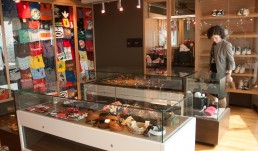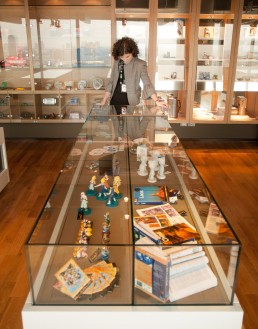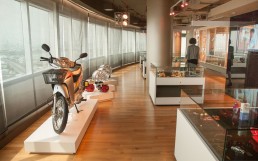At Thailand's Museum of Counterfeit Goods, this shamed writer learns that buying knock-off clothing and pirated movies can be a matter of life and death.
IT HAD BEEN A TYPICAL evening’s stroll along Bangkok’s bustling Sukhumvit Road, among the ramshackle street stalls that line that tourist-magnet thoroughfare. I bagged one knock-off Fred Perry polo shirt in navy blue and a pirated DVD copy of X-Men Origins: Wolverine, but both purchases proved disappointing.
The shirt, once tried on back at my hotel, appeared to have been made not from breathable cotton but from itchy polyester — hardly ideal for the sticky Thai climate — and the Hollywood blockbuster had been dubbed into Russian. I cursed the waste of 10 bucks on shoddy merchandise.
By the following afternoon, that remorse had morphed into full-blown guilt, when Clemence Gautier, an intellectual-property consultant with law firm Tilleke & Gibbins, took me on a tour of Bangkok’s Museum of Counterfeit Goods.
Covering 1,000 square feet and — with its polished wooden floors, shimmering glass display cases and subdued lighting — incongruously chic, the museum is incorporated into the firm’s offices on the 26th floor of the riverside Supalai Grand Tower. It is an Aladdin’s cave of thousands of illicit products, from fake designer handbags and spurious chewing gum to sham champagne.
ACCORDING TO GAUTIER, stallholders on Sukhumvit are not the main beneficiaries of dodgy transactions like mine. Criminal gangs are behind Asia’s black market in fake goods, and misguided shoppers like me are inadvertently supporting child labour, human trafficking and other nefarious practices by buying them.
The directness of Gautier’s revelations is sobering. “Money spent on counterfeits is easy profit for criminal organisations,” the soft-spoken French native says, “and supports other activities like prostitution and drugs.”
Gautier stands in front of a large wall of contraband streetwear. Lacoste, Adidas, Kappa, DKNY — all the labels and logos that are so prevalent on Sukhumvit, as well as in Bangkok’s backpacker ghetto of Khaosan Road and in neon-drenched Patpong market, are on display. And there, in the top left corner, a bootleg Fred Perry shirt hangs accusingly in violent pink.
“In countries like Vietnam and Cambodia, very often it’s kids involved in the manufacturing,” Gautier says. “People think, ‘Oh, it’s just a T-shirt, and it’s no real harm,’ but we try to explain where the money is going. What if a 10-year-old girl is working every day to make those T-shirts?”
ESTABLISHED IN 1890, Tilleke & Gibbins is Thailand’s oldest law firm. It got involved in intellectual property law in the early 1980s, and by 1989 the company had stockpiled so many phoney bags, items of clothing and sunglasses as evidence in its IP cases that a senior partner decided they could do a valuable public service by putting them on display.
In today’s troubled economic times, the role of the appointment-only museum is arguably growing in importance as consumers worldwide become desperate for bargains. Security experts with Hong Kong–based consultancy Asia Risk recently estimated that international trade in counterfeit goods could rise to nearly US$1 trillion in 2009. The business has long exceeded the value of the global narcotics trade.
“North African radical fundamentalist groups in Europe, al-Qaeda and Hezbollah all derive income from counterfeiting. This crime has the potential to become the preferred source of funding for terrorists”
Interpol officer John Newton, as quoted in The Times
As early as 2005, in fact, high-end fashion houses such as Burberry and Louis Vuitton were warning that profits from cheap reproductions of their desirable goods might be used to fund terrorist organisations. Many people were sceptical about alarm bells emanating from such well-heeled manufacturers until Interpol backed up the claims.
“North African radical fundamentalist groups in Europe, al-Qaeda and Hezbollah all derive income from counterfeiting,” John Newton, an Interpol officer specialising in IP crime, told the UK’s Times newspaper. “This crime has the potential to become the preferred source of funding for terrorists.”
The most surprising thing about Bangkok’s Museum of Counterfeit Goods, however, is the sheer diversity of its exhibits. Any visitor to the Thai capital will be familiar with the knock-off Rolex and Tag Heuer watches, the G-Star jeans and the Nike sneakers. But rip-off shampoo and candy? Toothpaste that might have been cobbled together in a grubby lab on the outskirts of Ho Chi Minh City? Ballpoint pens? Staples?
For a moment my guilt dissipates and I wonder why I’ve sacrificed an afternoon to a museum showcasing things to be found in any stationery store. (I could, after all, be at Bangkok’s Siriraj Medical Museum, where the preserved corpse of Thailand’s most notorious serial killer and cannibal is on display, as well as a deformed human testicle that is 45cm in diameter.)
But a skip through the counterfeit museum offers more than macabre trivia. In many cases, the global trade in fakes is a matter of life and death. Fake pharmaceutical drugs — their active ingredients either missing or present in insufficient volumes to be effective — are proving increasingly difficult to discern by IP investigators.
“The technology used to copy holograms [on drug packaging] is so good now that manufacturers have to change them all the time,” Gautier says. “It’s difficult to stay in front.”
GAUTIER ALSO EXPLAINS that product counterfeiting, as with legitimate industries, is frequently determined by geography, with some countries having developed expertise in certain products. Cambodia, for instance, is to knock-off name-brand cigarettes what Belgium is to quality chocolates. Malaysia pumps out pirated DVD movies faster than the Scots can sink single malts.
And China? Secreted factories across China are copying just about everything you can imagine, says Gautier. “If there’s money to be made, there’s not much that people will not to try to copy these days.”
While I am heading back to the hotel in a cab, one of Bangkok’s countless motorbike taxis weaves erratically through the traffic. A young woman rides side-saddle behind the bike’s pilot, and I flinch at the potential for tragedy: there was a complete scooter on display in the museum, and Gautier told me that every single component — tires, brakes, fuel tank and all — had been manufactured on the sly.
As my taxi veers east onto Sukhumvit Road, the street traders are busy erecting their stalls for another evening of commerce. But me? Tonight I’ll hole up in the hotel. I’ll chuck that Fred Perry in the bin, order a pizza (is it possible to fake a pizza?) and catch a flick on HBO. Shopping is just too scary. ◉
This 'Postcard From Bangkok' ran in Time in June 2009.
SHARE





